Karachi Haat - a paradise for craft lovers
Artisans from across Sindh display their work at enclosure inside National Museum

48 artisans are displaying their products in a rural setting at Karachi Haat. PHOTO: ATHAR KHAN
The place is called Karachi Haat where 48 artisans are displaying their products in a rural setting at the shops. It has become a go-to place for all those who are interested in local crafts. For sellers, Karachi Haat serves as a place where they can meet potential buyers and sell their crafts without any middlemen, whereas for buyers the enclosure offers a variety of indigenous crafts under one roof.
The haat, which is Hindi for rural bazaar, has been built with red bricks. It houses artisans who make handicrafts to earn their living. Some of these artisans have been creating crafts whose techniques are centuries old that have been passed on for generations.
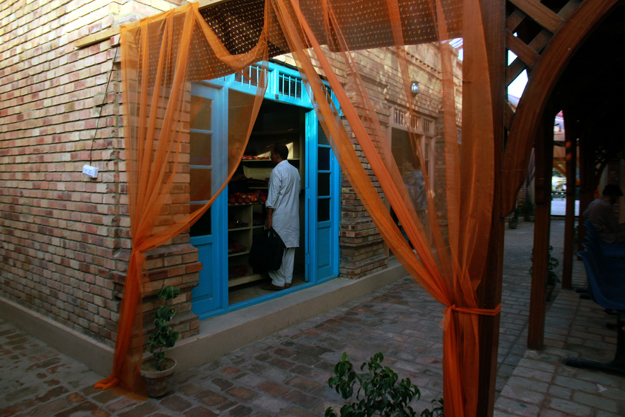 For sellers, Karachi Haat serves as a place where they can meet potential buyers and sell their crafts without any middlemen. PHOTO: ATHAR KHAN
For sellers, Karachi Haat serves as a place where they can meet potential buyers and sell their crafts without any middlemen. PHOTO: ATHAR KHANKarachi Haat is being looked after by the Sindh Indigenous and Traditional Crafts Company (Sitco) for the last three years in collaboration with the culture department. It is being funded through an endowment fund of Rs200 million established by the government.
Since its inception on April 3, three batches of artisans have displayed their products at the bazaar that remains open from Fridays till Sundays between 3pm and 9pm. However, it is closed during Ramazan.
A wide array of products
A 43-year-old artisan, Razzak Dino, who is a master of the art of block printing with natural dye, said if such a market continued, it would bring prosperity to artisans and facilitate buyers.
Explaining the technique of his craft, Dino said it took 12 to 13 days to make one batch of goods as they have to pass through various stages. We wash a cloth for three days and then print different colours one by one for a few more days, after which we dry the cloth and leave it for another day so the colour becomes permanent, he said, adding that the cloth is washed again as the last step.
The artisan explained that all the colours he uses are extracted from natural products. Mustard colour is extracted from pomegranate skin while indigo is extracted from another plant, he said.
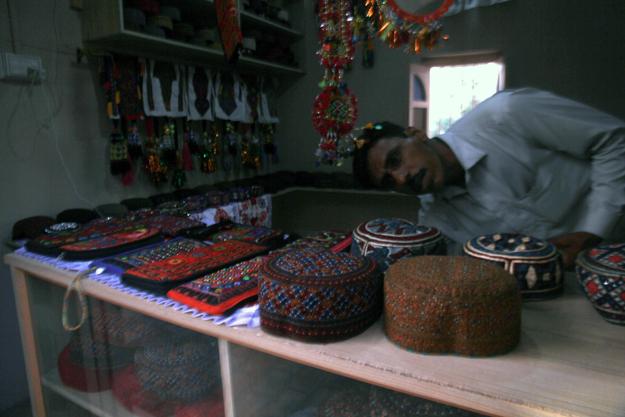 A vendor displaying Sindhi topis and other crafts. PHOTO: ATHAR KHAN
A vendor displaying Sindhi topis and other crafts. PHOTO: ATHAR KHANThe colours become permanent after passing through various processes and later clothes are treated in hot water with a substance called sakun for up to three hours so that all the dyes becomes permanent.
Dino is not only displaying and selling his products at Karachi Haat but is also getting new ideas from visitors at the place. I have been asked to make bags for laptops with block printing, he said.
Khadim Hussain Kumbhar, who is a primary teacher at a government school, said he learnt the art of kashi (glazing) from his father. "I do this as a part-time job along with my sons who go to school. We can't discontinue it as it has been our family's identity for centuries," he said. According to him, the government should make handicraft art a compulsory subject at schools so that children who drop out still have some skills.
"It takes eight days to make a batch of products from our line," he said. According to him, making pottery is the first step of his craft, after which floral patterns are made, including kashi.
Local artisans show off work at Sindh Craft Festival
Kumbhar maintained that he performed all the steps himself, as relying on others often results in delays. The artisan had a variety of beautiful vases, plates, mugs, glasses and other items at his shop that were attracting visitors.
People complain that the items are expensive but they are handmade products, which require very hard work, he said. "We, the artisans, are competing with machines. Handicrafts made by us have their own prestige and those who [want to buy them] don't even bargain," he said.
Kumbhar praised Sitco for providing transportation, lodging and even food allowance to the artisans who also do not have to pay any rent. "If these places are not present in Karachi, we would not come to the city nor would we have buyers for out crafts and ultimately our centuries-old crafts would die out," he said.
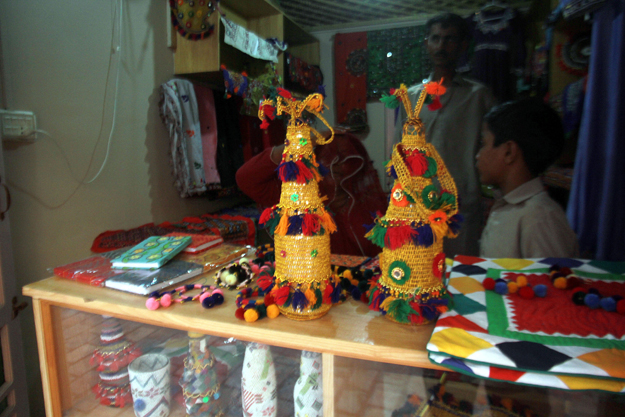 According to buyers, Karachi Haat is an amazing initiative for artisans and those interested in handicrafts. PHOTO: ATHAR KHAN
According to buyers, Karachi Haat is an amazing initiative for artisans and those interested in handicrafts. PHOTO: ATHAR KHANShrimati Kumari, who came from Kolhi Daro near Umerkot, was running a shop of Thari embroidery. Full of vivid colours and beads, her products were attracting visitors. She explained she did not earn much by selling her crafts in her village, which was the reason she came to Karachi Haat where she was able to sell enough items in three days. "We sell goods [at Karachi Haat] and also get orders here and when we go back, we ask artisans in our village, including women, to fulfil those orders," she said.
There was also a dedicated shop for Sindhi topis, which are considered a representative handicraft of the province. According to Mahnthar Ali from Nawabshah, who himself is a well-known artisan of Sindhi topis, a large number of his products are exported to Afghanistan, the United Arab Emirates and other Middle Eastern countries.
The quality of a Sindhi topi depends on how many days of labour have been dedicated to it, he said, adding that its price can go as high as Rs12,000. However, Ali added that a fine cap can be purchased from his shop at only Rs1,000.
Sindhi topis worn in every district of Sindh are different from others, the artisan said, adding that the topi being worn in a particular area serves as an identification mark of that area and the tribes residing there.
Beesham Lal, who was exhibiting Sindh khusso with embroidery, hailed from Kandhkot. He claimed that his father Khan Chand held exhibitions of his handicrafts in India and London.
A meticulous craft: Exploring the magical world of clay
Six people work for two days to make one handmade original leather khusso, Lal said, adding that it was sold for Rs2,000.
Coming to Karachi all the way from Sobho Dero in Khairpur, Muhammd Edal displayed khes at a shop. Giving a historical background of the product, he said khes were given as a souvenir by the Mirs - the rulers of Khairpur state. The thread that was used at that time to make khes was made of gold and pure silk, he said.
Edal lamented that craft of making khes was dying, adding that his family was also not willing to stick to the profession. He feared that the coming generations would altogether give up the craft as it would not be financially feasible for them.
Other indigenous crafts on display included woodwork items crafted by Ali Bux from Kashmore. Another shop featured chunris that were made by Rab Dino Khatri who claimed to be a professional dyer.
Buyers and organisers
Waqar J Khan, one of the buyers who is also a fashion designer, said that it was an amazing initiative for artisans and those interested in handicrafts.
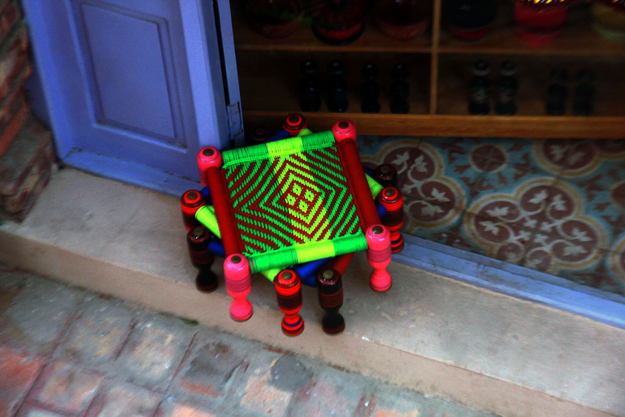 The main purpose of Karachi Haat is to connect artisans with their potential buyers, said Sitco Director Shakil Abro. PHOTO: ATHAR KHAN
The main purpose of Karachi Haat is to connect artisans with their potential buyers, said Sitco Director Shakil Abro. PHOTO: ATHAR KHANAccording to him, Karachi Haat enabled craft lovers to interact with artisans. All those who are exhibiting here are very refined artisans, he said.
Another visitor, Dr Maria Fletcher, said this was the third time she was visiting Karachi Haat. She said that during their second visit, her husband bought her a block-printed suit while she bought some decoration pieces for her home. Her husband, Albert Fletcher, said this initiative should continue as it encouraged local artisans.
The main purpose of Karachi Haat is to connect artisans with their potential buyers, said Sitco Director Shakil Abro. "Those who want to work with artisans [visit Karachi Haat] and place orders on a larger scale [due to which] there is a continuous sale of crafts."
According to Abro, the company has shortlisted 500 artisans for Karachi Haat. He said artisans needed to keep responding to the demands of the urban market.
Three-day event: Youth cultural mela concludes
"Needy artisans are also being provided raw materials so that they can prepare final products to be sold at Karachi Haat," the director remarked.
Commenting on the dying state of crafts in the province, Abro said artisans were abandoning their ancestral work because of financial reasons. He added that initiatives like Karachi Haat help artisans earn money and sustain rural economies. Through such initiatives, no craft will be a dying craft as new clusters of artisans will keep emerging, he explained.





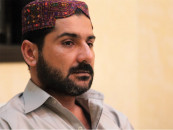












COMMENTS
Comments are moderated and generally will be posted if they are on-topic and not abusive.
For more information, please see our Comments FAQ